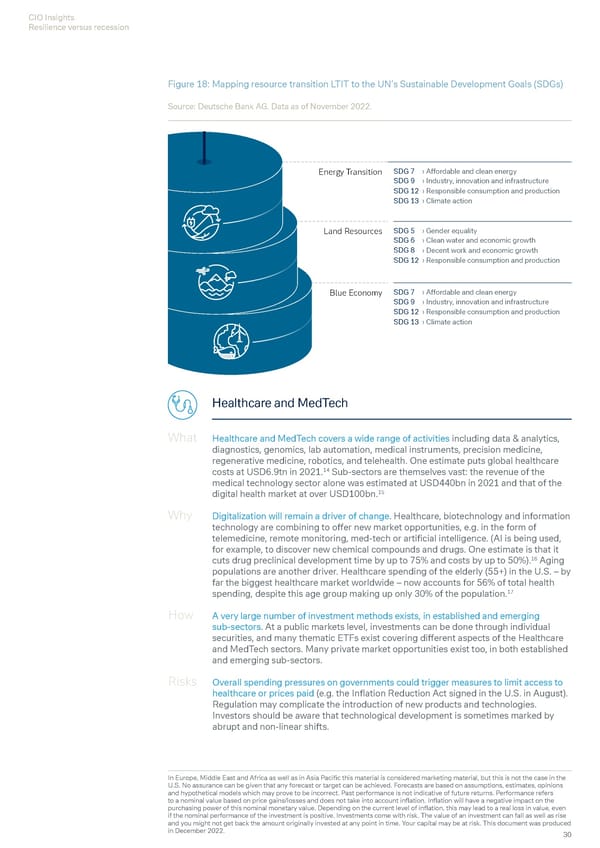CIO Insights Resilience versus recession Figure 18: Mapping resource transition LTIT to the UN’s Sustainable Development Goals (SDGs) Source: Deutsche Bank AG. Data as of November 2022. Energy Transition SDG 7 › Affordable and clean energy SDG 9 › Industry, innovation and infrastructure SDG 12 › Responsible consumption and production SDG 13 › Climate action Land Resources SDG 5 › Gender equality SDG 6 › Clean water and economic growth SDG 8 › Decent work and economic growth SDG 12 › Responsible consumption and production Blue Economy SDG 7 › Affordable and clean energy SDG 9 › Industry, innovation and infrastructure SDG 12 › Responsible consumption and production SDG 13 › Climate action Healthcare and MedTech What Healthcare and MedTech covers a wide range of activities including data & analytics, diagnostics, genomics, lab automation, medical instruments, precision medicine, regenerative medicine, robotics, and telehealth. One estimate puts global healthcare costs at USD6.9tn in 2021.14 Sub-sectors are themselves vast: the revenue of the medical technology sector alone was estimated at USD440bn in 2021 and that of the digital health market at over USD100bn.15 Why Digitalization will remain a driver of change. Healthcare, biotechnology and information technology are combining to offer new market opportunities, e.g. in the form of telemedicine, remote monitoring, med-tech or artificial intelligence. (AI is being used, for example, to discover new chemical compounds and drugs. One estimate is that it 16 cuts drug preclinical development time by up to 75% and costs by up to 50%). Aging populations are another driver. Healthcare spending of the elderly (55+) in the U.S. – by far the biggest healthcare market worldwide – now accounts for 56% of total health spending, despite this age group making up only 30% of the population.17 How A very large number of investment methods exists, in established and emerging sub-sectors. At a public markets level, investments can be done through individual securities, and many thematic ETFs exist covering different aspects of the Healthcare and MedTech sectors. Many private market opportunities exist too, in both established and emerging sub-sectors. Risks Overall spending pressures on governments could trigger measures to limit access to healthcare or prices paid (e.g. the Inflation Reduction Act signed in the U.S. in August). Regulation may complicate the introduction of new products and technologies. Investors should be aware that technological development is sometimes marked by abrupt and non-linear shifts. In Europe, Middle East and Africa as well as in Asia Pacific this material is considered marketing material, but this is not the case in the U.S. No assurance can be given that any forecast or target can be achieved. Forecasts are based on assumptions, estimates, opinions and hypothetical models which may prove to be incorrect. Past performance is not indicative of future returns. Performance refers to a nominal value based on price gains/losses and does not take into account inflation. Inflation will have a negative impact on the purchasing power of this nominal monetary value. Depending on the current level of inflation, this may lead to a real loss in value, even if the nominal performance of the investment is positive. Investments come with risk. The value of an investment can fall as well as rise and you might not get back the amount originally invested at any point in time. Your capital may be at risk. This document was produced in December 2022. 30
 Deutsche Bank Economic and Investment Outlook Page 31 Page 33
Deutsche Bank Economic and Investment Outlook Page 31 Page 33